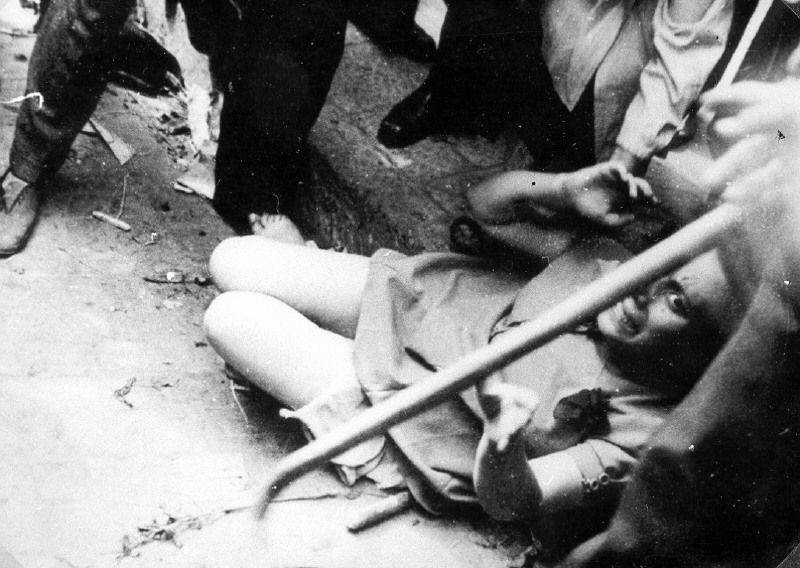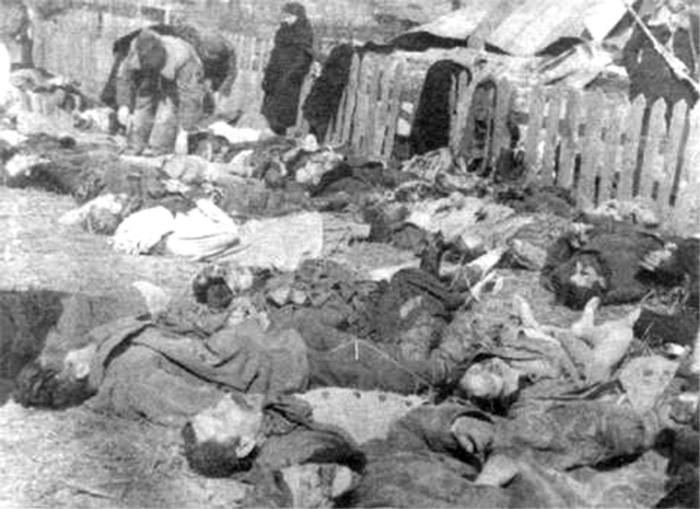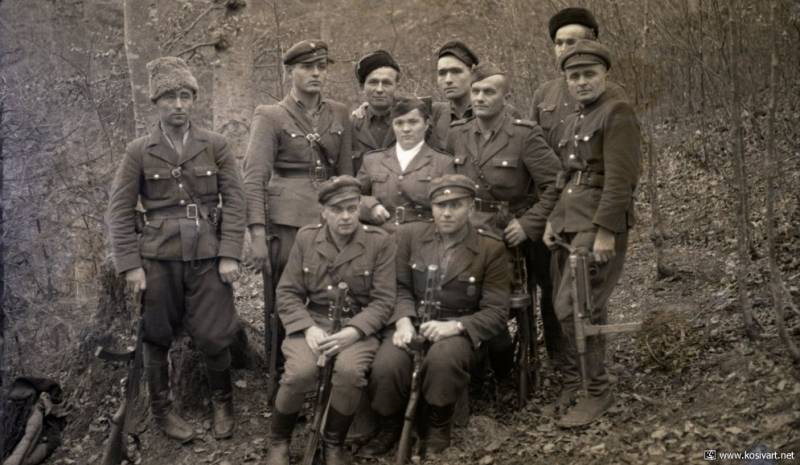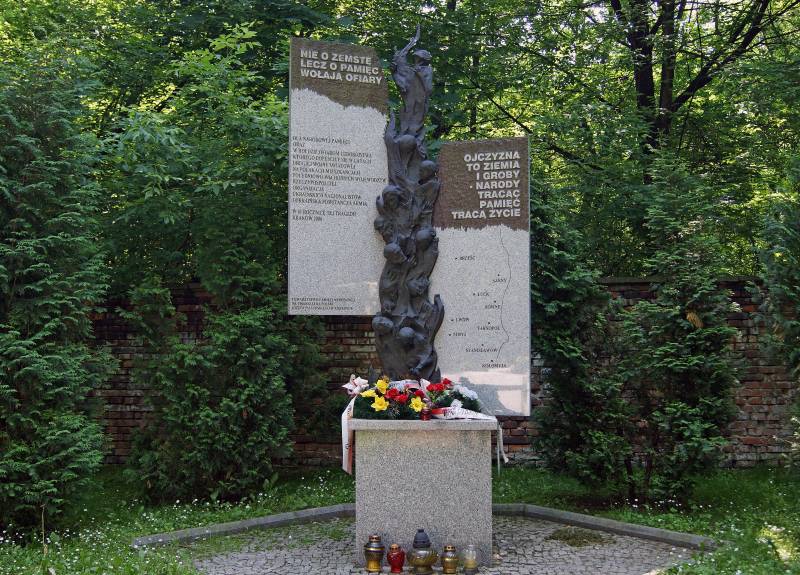The extermination of the Poles in Ukraine. Volyn Massacre
Ukrainian nationalists felt the power immediately, as soon as the Nazi troops entered the territory of Ukraine. Already in the 1941 year, they participated in the killings of not only Komsomol workers, party functionaries and Red Army men, but also members of national minorities - Jews and Poles. The story included the infamous Lviv pogrom, which was well documented. German troops entered Lviv on the morning of 30 on June 1941 of the year, on the same day local pogroms began in the city, which on July 1 turned into a massive Jewish pogrom. At the same time, the harassment, murder and torture of the mainly Jewish population of Lviv continued for several days. During this time, members of the newly formed “Ukrainian people's militia”, nationalists and volunteers from among the residents of the city managed to exterminate about four thousand Jews in Lviv.
From the internal documents of the OUN-UPA * published already in the post-war years, * it follows that not only Jews and Russians, but also Poles, were considered enemies of Ukrainian statehood. At the same time, ethnic cleansing of the Polish population was planned before the start of the Second World War. For example, the military doctrine of the Ukrainian nationalists, which was developed in the spring of 1938, contains the theses on the need to “wipe out the foreign Polish element from the Western Ukrainian lands” down to the last person. So the Ukrainian nationalists wanted to put an end to Polish claims to these territories, which for centuries were part of different states. At the same time, the Red Army, which occupied the territory of Western Ukraine in the 1939 year, first prevented the Ukrainian nationalists from implementing their plans. True, the postponement for the Poles did not last long.
In 1941, the OUN-UPA * issues another instruction on its activities and struggle. The “People’s Militia” attributed this document to the “neutralization” of Poles, who did not renounce their dream of creating Greater Poland, which includes lands located in northwestern Ukraine. Including the historical region - Volyn.

It should be noted that Volyn is an ancient region, which in the 10th century was part of Kievan Rus (Volyn, and then Vladimir-Volyn principality). Later, these lands were ceded to the Principality of Lithuania, and then to Poland. After several sections of the Polish-Lithuanian Commonwealth, the region became part of the Russian Empire. In 1921, the western part of Volyn was transferred to Poland, and the eastern part to the Ukrainian SSR. In 1939, Western Volyn was also annexed to the Ukrainian SSR. During the Great Patriotic War, this geographical area was occupied by Hitler's troops.
The historical background accumulated over many centuries, the ethnic disunity of the region and numerous old grievances against each other may have become a kind of fuse that set fire to a powder keg and led the entire region, first of all its peaceful population, to a real catastrophe. By the end of the first third of the 20th century, a persistent Polish-Ukrainian territorial and ideological confrontation developed. Over the centuries, both sides managed to repeatedly commit numerous atrocities against each other, which, however, did not go beyond the usual practice of that time period. At the same time, the events that occurred in Volyn during the Second World War, by their bloody and cruelty, overshadowed medieval history.
The UPA itself - the Ukrainian Insurgent Army, as the wing of the Organization of Ukrainian Nationalists (Bandera Movement) *, was formed in 1942 year. The impetus for her education was the victory of the Red Army at Stalingrad. After this victory, Soviet troops began the liberation of the lands occupied by the Germans and their allies, and they were getting closer to the Ukraina Reich Commissariat, which was created in 1941 by the German occupying forces on the territory of the Ukrainian SSR. At the same time, almost from the very first days of the formation of the UPA *, the destruction of the ethnic Polish population began.
Ukrainian nationalists fully enjoyed their own impunity. After the retreat of the Red Army, there was practically no one to oppose the OUN-UPA * gangs. The Soviet partisan movement was the most widespread on the territory of Belarus, and the Poles themselves did not have a sufficient number of well-armed units that could provide decent resistance to the Ukrainian nationalists.
The Volyn Massacre forever (the mass extermination of the Polish population) began in the winter of the year 1943. The starting point for this tragedy is called February 9 1943 of the year. On this day, the militants of the OUN-UPA * entered the Polish settlement of Parosl under the guise of Soviet partisans. In the period between the First and Second World Wars, Parosl was a small village on 26 houses, located near the town of Sarny, which is currently located in the Rivne region of Ukraine. By the time of the massacre, the ethnic Polish population was, according to various estimates, from 15 to 30 percent of all Volyn inhabitants. After resting and eating in the homes of the locals of Parosley, Bandera began a massacre. They did not spare anyone: they killed men and women, old people and babies. Just because the locals were Poles. According to various estimates, in the village were killed from 149 to 179 local residents, including several dozen children. At the same time, Ukrainian nationalists showed bestial cruelty, most were simply hacked to pieces with axes. Also in the course were knives and bayonets. Survive managed units.
The Polish population was exterminated by Ukrainian nationalists throughout the whole territory of Western Ukraine according to the same scenario: several armed gangs surrounded Polish settlements, all residents were gathered in one place and systematically destroyed. American historian Timothy Snyder noted that Ukrainian nationalists had learned the technology of mass destruction from the Germans. Therefore, all the ethnic cleansing carried out by the UPA * was so nightmarish. And that is why, in 1943, the Volyn Poles turned out to be almost as helpless as the Volyn Jews in 1942, the historian notes.
It often happened that their neighbors, ordinary Ukrainians, often fellow villagers, took part in actions against the Polish population. The houses of the murdered Polish families were burned, and all valuable property was simply plundered. In this case, a distinctive feature was that they killed mostly cold weapons and improvised means, agricultural equipment, not firearms. Shooting in such a situation was an easy death. Wielding axes, saws, knives, bayonets, stakes, supporters of independent Ukraine exterminated tens of thousands of innocent civilians.
The atrocities of the Ukrainian nationalists in Volyn are confirmed by numerous documentary evidence, photographs, testimonies by a miracle of survivors and interrogations of the performers themselves, a large amount of information is stored in the archives of the special services. For example, the commander of one of the UPA platoons * Stepan Redesh during interrogations testified that in some cases the Poles were thrown alive into wells, and then finished off from a firearm. Many were slaughtered to death with clubs and axes. The protocol of interrogation of the criminal states that he personally participated in a single operation against the Polish population, it occurred in August 1943. According to Redesh, the operation involved more than two smoking units consisting of 500 people with weapons and over a thousand people from the OUN underground *, who were armed with axes and other improvised means. “We surrounded five Polish villages and burned them overnight and the whole population from infants to old people were slaughtered, more than two thousand people were killed in total. My platoon took part in the burning of a large Polish village and the elimination of farms close to it, we cut out about a thousand Poles, ”said a Ukrainian nationalist during interrogation.

In the detachments of the Ukrainian nationalists who participated in the massacres of the Polish population, there were so-called “Rezuns” - militants who specialized in the execution of cruel executions and used for the killings mainly edged weapons - axes, knives, two-handed saws. They in the true sense of the word cut out the civilian population of Volyn. At the same time, Polish historians, who worked on the study of the Volyn Massacre, counted about 125 methods of killing, which the Rezuns used in their reprisals. One description of these methods of killing the blood of a normal person literally freezes in his veins.
Particularly mass and bloody events occurred in Volyn on the night of 11 July 1943, when numerous UPA units * attacked simultaneously 150 of Polish villages, villages and farmsteads. In just one day, more than ten thousand people died. For example, 11 July 1943, in Kiselyn, 90 people were killed right away, who gathered for a mass in the local church, including the priest Alexei Shavlevsky. In total, according to various estimates, the Volyn Massacre killed up to 60 thousands of Poles (directly on the territory of Volyn), and the total number of killed Poles throughout Western Ukraine is estimated at about 100 thousands. During the Volyn Massacre, almost the entire Polish population of the region was destroyed.
The atrocities of the nationalists of the OUN-UPA * could not fail to receive a response from the Poles. For example, units of the Home Army also raided Ukrainian villages, including conducting their own actions of retaliation. It is believed that they killed several thousand Ukrainians (up to 2-3 thousands of civilians). The total number of dead Ukrainians can reach 30 thousands. It should be borne in mind that a significant part of them could have been killed by their compatriots - Ukrainian nationalists. The UPA * fighters killed Ukrainians who tried to help the Poles and save them, they also demanded that Ukrainians with a mixed family kill the closest Polish relatives. In case of failure, everyone was killed.
The massacres of Poles and Ukrainians were stopped only after the entire territory of Ukraine was liberated by the Red Army fighters. Moreover, even then, it was no longer possible to reconcile the two peoples among themselves. That is why in July 1945, the USSR and Poland entered into a joint agreement on the exchange of population. The Poles who lived in the territories that were part of the Soviet Union moved to the territory of Poland, and the Ukrainians who lived on Polish lands went to the territory of the Ukrainian SSR. The resettlement operation was codenamed “Wisla” and lasted for almost two years. During this time, more than 1,5 millions of people were resettled. Such a "resettlement of peoples" has reduced the degree of tension between the Poles and Ukrainians. At the same time, throughout the entire Soviet history, this painful topic was once again tried not to be remembered or touched. Volyn Massacre was not widely publicized in the USSR, and in the Polish People's Republic in those years there were only a few works devoted to this tragedy. Again, historians and the general public returned to these events only in the 1992 year, after the collapse of the USSR.
The policy of the new Kiev leadership in recent years has exacerbated many historical issues between Poland and Ukraine. Thus, Warsaw has consistently condemned Kiev for the glorification of members of the OUN-UPA *, as well as regular acts of vandalism, which are held in relation to Polish places of memory. In July 2016, the Polish Sejm recognized 11 July as the National Day of Remembrance for the Victims of the Genocide of the Citizens of the Republic of Poland, perpetrated by Ukrainian nationalists. At the same time, the Polish Prime Minister announced not so long ago that the final reconciliation between the Polish and Ukrainian people will become possible only when the truth about the Volyn Massacre is recognized.
At the same time, according to RIA "News”, The Ukrainian authorities insist on revising the provisions of the Polish Law On the Institute of National Memory, which concerns Ukrainians. This law, which came into force in the spring of 2018, provides for criminal liability for the propaganda of the “Bandera ideology” and the denial of the Volyn Massacre.
* Extremist organizations prohibited in the Russian Federation.
Information sources:
https://ria.ru/defense_safety/20180711/1524304863.html
https://www.gazeta.ru/science/2018/02/09_a_11642473.shtml?updated
http://www.aif.ru/society/history/volynskaya_reznya_geroi_ukrainy_ubivali_polyakov_ot_mala_do_velika
Open source materials


Information